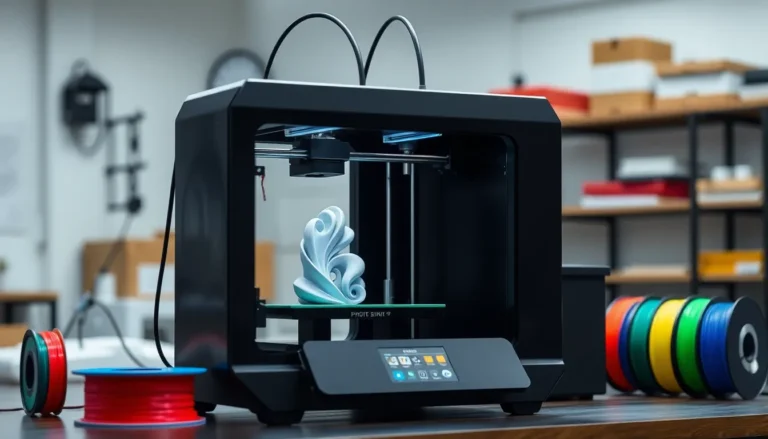Table of Contents
ToggleEver thought about building your own calculator? It’s not just for math whizzes; it’s a fun way to dive into Python programming! Imagine impressing your friends with a custom calculator that can handle everything from simple addition to complex equations. Plus, who wouldn’t want to show off their coding skills while solving everyday math problems?
Understanding The Basics Of Python
Python serves as a versatile programming language, ideal for beginners and seasoned developers. Familiarity with its fundamentals enhances the understanding necessary for creating applications like a calculator.
What Is Python?
Python is a high-level programming language known for its readability and simplicity. Designed in the late 1980s, it emphasizes clear syntax and code legibility. It supports multiple programming paradigms, including procedural and object-oriented programming. Developers use Python in various domains such as web development, data analysis, artificial intelligence, and scientific computing. Popular frameworks like Django and Flask enhance its functionality for web applications. Growing communities contribute robust libraries, which facilitate rapid application development.
Why Use Python For Programming?
Python’s extensive libraries offer pre-built functionalities, simplifying complex tasks. Since the language is easy to learn, beginners find it accessible. Versatility makes Python suitable for various projects, from simple scripts to large-scale applications. Its active community provides support, ensuring developers can find solutions quickly. Cross-platform compatibility allows applications to run on different operating systems seamlessly. Efficiency in writing concise code enhances productivity, allowing developers to focus on problem-solving rather than syntax issues. Python’s popularity continues to rise, contributing to its wide-ranging applications.
Setting Up Your Python Environment

Setting up a Python environment is crucial for building a custom calculator. This process ensures that all necessary tools are in place for seamless development.
Installing Python
To begin, download the Python installer from the official Python website. Users can choose between the latest stable version or an older release, depending on their needs. After downloading, execute the installer to start the installation process. A checkbox for adding Python to the system PATH appears; selecting it simplifies future command-line access. Once the installation finishes, verify the setup by opening a terminal or command prompt and typing python --version. This command displays the installed version, confirming successful installation.
Choosing An IDE
Selecting an Integrated Development Environment (IDE) enhances programming efficiency. Popular choices include PyCharm, Visual Studio Code, and Jupyter Notebook. PyCharm offers robust features for larger projects, while Visual Studio Code is lightweight and highly customizable. Jupyter Notebook excels in data-driven applications, providing an interactive coding experience. After choosing an IDE, download and install it following the provided instructions. Users benefit from additional features like debugging tools and extension support, making coding more manageable and enjoyable.
Key Concepts For Building A Calculator
Building a calculator requires an understanding of key programming concepts. Familiarity with these elements makes the coding process more efficient and intuitive.
Variables and Data Types
Variables serve as containers for storing data. In Python, selecting the right data type is essential for accurate calculations. Common types include integers, floats, and strings. Integers represent whole numbers, while floats handle decimal values, offering precision in computations. Strings, on the other hand, enable users to work with text, such as displaying user prompts or error messages. Clear variable names enhance code readability by indicating their purpose. This practice aids in maintaining and debugging the code, making future alterations straightforward.
Control Structures
Control structures dictate the flow of the program. They enable decision-making processes within the calculator. The most common structures include if statements, for loops, and while loops. If statements allow the program to execute specific actions based on user inputs or conditions. For loops can iterate through a sequence, useful for repeated calculations or displaying results. While loops offer the capability to run code until a certain condition is met, allowing for continuous operation of the calculator. By mastering these structures, developers create more dynamic and functional applications.
Step-By-Step Guide To Making A Calculator
Creating a calculator in Python involves several steps. Each section outlines the essential components required to build an efficient and functional program.
Designing The Calculator
Designing the calculator layout serves as the initial step. Start by deciding the operations to include, such as addition, subtraction, multiplication, and division. Organizing user inputs effectively influences usability. Sketching a simple user interface helps visualize the design before coding. Consider using clear prompts to guide users in entering their calculations. Prioritize functionality by ensuring that the layout accommodates both basic and advanced features for future expansions.
Implementing Basic Operations
Implementing basic operations forms the core of the calculator’s functionality. Define functions to handle each mathematical operation. For instance, create an add function that takes two parameters and returns their sum. Code similar functions for subtraction, multiplication, and division. Using input statements, prompt users to enter numbers for operations. Additionally, ensure error handling for dividing by zero or invalid inputs to improve user experience. This foundational work builds confidence for adding more complex features later.
Adding Advanced Features
Adding advanced features enhances the calculator’s capabilities. Integrate functions for exponentiation and square root calculations. Incorporate the use of libraries, such as math, to gain access to more complex mathematical functions. Implement a memory function that allows users to store and retrieve previous results. Consider adding a graphical user interface with libraries like Tkinter to make the calculator visually appealing. Prioritizing user feedback enables further enhancements and upgrades for the application in the future.
Testing Your Calculator
Testing ensures the calculator functions as intended. Verifying each operation helps identify and resolve issues promptly.
Debugging Common Errors
Errors often occur during calculator development. Division by zero is a frequent mistake that can cause crashes. Implementing try-except blocks captures such exceptions effectively. Syntax errors in functions arise when parentheses or colons are missing. Regularly reviewing code for typos ensures clarity and correctness. Utilizing debugging tools provided by IDEs makes tracking issues easier. Running individual operations in isolation helps pinpoint where errors arise. Adopting systematic tests for each function provides insights into potential problems.
Ensuring User Input Handling
User input handling enhances the calculator’s reliability. Validating inputs before processing ensures that calculations receive appropriate data types. Implementing checks for non-numeric inputs prevents runtime errors. Offering clear messages to users helps them understand mistakes. An intuitive interface guides users toward entering valid numbers. Providing default values or instructions can improve user engagement. Utilizing loops to prompt for correct input makes the application more user-friendly. Testing edge cases, such as extremely large numbers, helps demonstrate the robustness of the calculator.
Building a calculator in Python is not just a fun project but also a valuable learning experience. It allows individuals to apply their coding skills while exploring mathematical concepts. By following the outlined steps and utilizing the recommended tools, developers can create a functional and user-friendly calculator.
Testing and refining the calculator ensures it operates smoothly and meets user expectations. Embracing this project can lead to greater confidence in programming and an understanding of Python’s capabilities. As users advance, they can enhance their calculators with more complex features and interfaces, showcasing their growth as developers.








